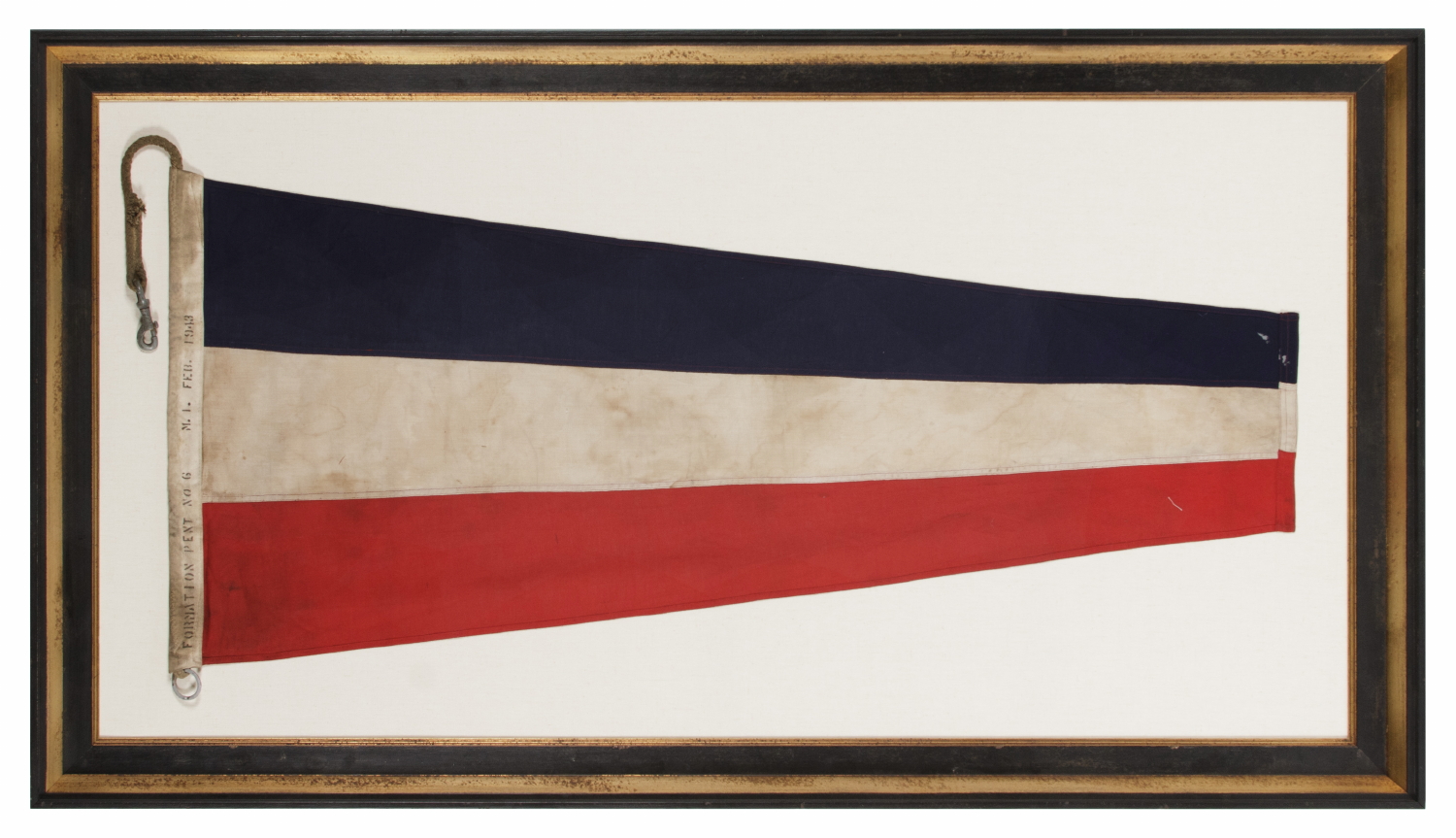
| |
U.S. NAVY FORMATION PENNANT, MADE AT MARE ISLAND, CALIFORNIA DURING WWII, SIGNED AND DATED 1943 |
|
| Available: |
Sold |
| Frame Size (H x L): |
66.75" x 36.5" x 5" deep |
| Flag Size (H x L): |
52.5" x 24" |
|
| Description....: |
|
U.S. Navy formation pennant, made during World War II (U.S. involvement 1941-45) and signed along the reverse side of the hoist with a black stencil that reads: "Formation Pent No. 6 M.I. [Mare Island] Feb. 1943.”
Located on the western edge of the City of Vallejo, about 23 miles northeast of San Francisco, Mare Island (actually a peninsula) served as a principal seat of U.S. Navy defense, beginning in the mid-19th century. The site was originally chosen following an expedition that set forth in 1850, when Commodore John Drake Sloat was ordered to lead a survey party in quest of a logical site for the nation's first Pacific naval installation. Sloat recommended the island across the Napa River from the settlement of Vallejo; it being "free from ocean gales and from floods and freshets." On November 6th of that year, two months after California was admitted to statehood, President Fillmore reserved Mare Island for government use. The U.S. Navy Department acted favorably on Commodore Sloat's recommendations and Mare Island was purchased in July, 1852, for the sum of $83,410 for use as a naval shipyard. Two years later, on September 16th of 1854, Mare Island became the first permanent U.S. naval installation on the West Coast, with Commodore David G. Farragut serving as Mare Island's first base commander.
The base became home to what was known as the Pacific Fleet, and remained so until the threat of Japanese expansionism caused the shift to a more advanced position at Pearl Harbor. It was very active in WWII, Korea, and Vietnam, but would eventually close in 1993 after Congress approved the findings of the Base Realignment and Closure Report.
The flag is made of either cotton bunting or a wool and cotton blended fabric, that has been pieced and sewn with machine stitching. There is a heavy canvas sleeve along the hoist, through which an especially heavy, braided cotton rope has been inserted and stitched into place, looped at both ends, with a metal ring at one end and a heavy metal clasp at the other. “No. 6,” part of the stencil, is a Navy size designation.
This signal was a surprisingly difficult one to research, especially given the fact that its name is printed directly on the hoist. The purpose seemed quite obvious, but I was unable to confirm until I spoke with several naval officers during an exhibition I put on at a U.S. Navy reception at the National Arts Club during New York’s Fleet Week. I finally found one who was familiar with it and related that it was to be flown by the lead ship in a convoy. It is not among the signals used in modern times.
Mounting: The flag has been hand-stitched to a background of 100% hemp fabric. The flag was then placed in a black-painted, hand-gilded and distressed Italian molding. The price includes glazing with U.V. protective Plexiglas, which simply hasn’t been added yet.
Condition: The flag was most certainly flow and presence evidence thereof. There is modest to moderate soiling in the stripes, accompanied by areas of moderate to significant soiling along the hoist binding. Many of my clients prefer vintage fags to show their age and history of use. |
|
|
|
| Collector Level: |
Intermediate-Level Collectors and Special Gifts |
|
| Flag Type: |
Sewn flag |
|
| Star Count: |
|
|
| Earliest Date of Origin: |
1943 |
|
| Latest Date of Origin: |
1943 |
|
| State/Affiliation: |
California |
|
| War Association: |
WW 2 |
|
| Price: |
SOLD |
|
| |
Views: 1051 |
|
|
|

